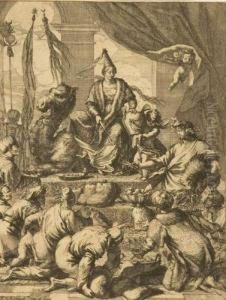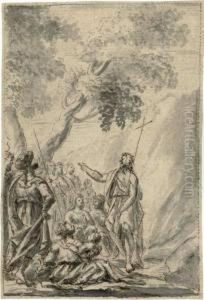Johann Jacob Von Sandrart Paintings
Johann Jacob von Sandrart was a German engraver and art dealer who lived during the Baroque period. He was born in 1655 into the Sandrart family, which was notable for its contributions to the arts, most prominently through his uncle Joachim von Sandrart, who was a well-known painter, engraver, and art writer of his time. Johann Jacob's career was significantly influenced by his uncle, from whom he likely received his initial training and introduction to the art world.
Johann Jacob von Sandrart’s works are less well-documented than those of his more famous uncle, but he still made a mark in the art world of his time. He worked primarily as an engraver, producing prints that were used to illustrate books and reproduce paintings. This was a common practice in the era before photography, where engravings were the primary means of disseminating images of artworks to a wider audience. Through his engravings, von Sandrart played a role in the spread of Baroque artistic styles and ideas throughout Europe.
In addition to his work as an engraver, von Sandrart was an art dealer. His dealings would have involved the buying and selling of artworks, which was a key aspect of the art market in the 17th century. Art dealers like von Sandrart were central figures in the art world, helping to establish the reputations of artists and the value of their works. His activities would have required a keen eye for quality and an understanding of the tastes and demands of art collectors of the time.
Johann Jacob von Sandrart's life and career were cut short when he died in 1698. While his own artistic legacy may not be as extensive or well-remembered as that of his uncle, his contributions to the art world through his engravings and dealings in the art market were part of the vibrant cultural exchange of the Baroque period. Today, his works are mainly of interest to specialists and historians who study the period and the intricate network of artists, patrons, and dealers who shaped the European art scene in the 17th century.

